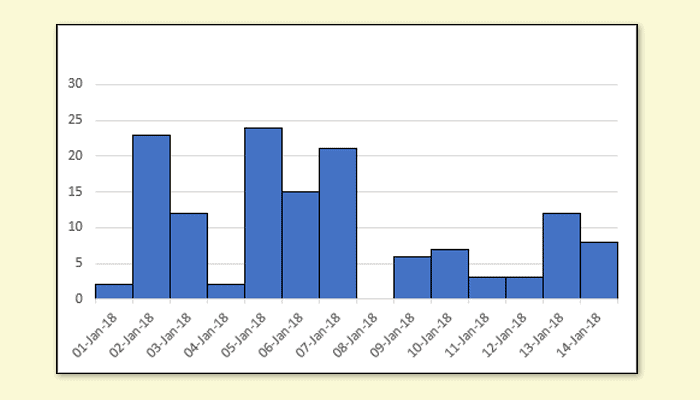
- EXCEL 2016 FOR MAC IS ONLY SHOWING ONE COLUMN IN CHART NEED MULTIPLE COLUMNS HOW TO
- EXCEL 2016 FOR MAC IS ONLY SHOWING ONE COLUMN IN CHART NEED MULTIPLE COLUMNS UPDATE
In this section, we're going to extend our conditional formatting rule so that cells with past dates will only be formatted in red if the related task is still outstanding. Format our cells based on the Due Date AND the task Status
EXCEL 2016 FOR MAC IS ONLY SHOWING ONE COLUMN IN CHART NEED MULTIPLE COLUMNS UPDATE
The use of the TODAY() function means that the spreadsheet will update automatically each day when you open or edit the spreadsheet. We've now completed the first part of this lesson - formatting a range of the dates in our spreadsheet so that cells containing Due Dates that are in the past will be formatted in red, as shown above. Once you've done this, you can click OK and the rule will be saved and applied as shown here: Note that you must put the = sign at the beginning of the function so that Excel knows you're entering a formula rather than just a text value: Here's how your completed rule should look once you enter the TODAY() function.

To do this, we'll replace the date shown with the TODAY() function which, conveniently, returns today's date. Remember that we want only want this rule to format cells that are in the past, i.e. However, our rule is not quite complete - we haven't finished configuring our criteria. all the cells we have selected) and format any cells that match our criteria with red text and light red shading. As you can see, this conditional formatting rule will format all cells (i.e. You'll now see a dialog box like the one below in which Excel has entered a date as the LESS THAN rule (note that Excel has entered a date automatically:Īt the same time, you may notice the selected cells have been formatted as a preview of the current rule, as shown here: highilight dates in the last 7 days), but it doesn't work in this scenario because it doesn't give us an option to choose all past dates. You may also notice another option in the list of Highlight Cells Rules, A Date Occurring. Next, click the Conditional Formatting button on the toolbar:Ĭhoose the Highlight Cells Rules option, and then select Less Than.
EXCEL 2016 FOR MAC IS ONLY SHOWING ONE COLUMN IN CHART NEED MULTIPLE COLUMNS HOW TO
In this section, we'll look at how to create a conditional formatting rule that formats the cells in the Due Date column if the task was due on a date that is in the past.įirst, select the cells you want to format: Each task has a status and a due date.įormat our cells by comparing the Due Date to the current date This is a simple Project Checklist spreadsheet that contains the tasks that need to be completed. Let's start by looking at the spreadsheet that we're going to work with. Using a formula as part of your conditional formatting rule is incredibly powerful, since you can incorporate cells from anywhere in your spreadsheet as part of the formula in your conditional formatting rule. You can also use custom formulas to decide whether to apply a specific formatting rule to a range of cells. Excel offers a set of standard conditional formatting options. Applying Conditional Formatting to DatesĬonditional Formatting in Excel allows you to format one or more cells based on the values in those cells.

So in this lesson, we'll look at how to apply the formatting to cells containing all dates in the past, not just those in the last month. These are simple and easy to apply but the problem for our scenario is that there isn't a built-in conditional formatting rule that applies to all dates in the past - the best you can do with the built-in rules is to format cells containing dates that are in the last month. Note that Excel's Conditional Formatting feature includes an option to highlight dates according to a range of pre-configured conditional formatting rules.


 0 kommentar(er)
0 kommentar(er)
